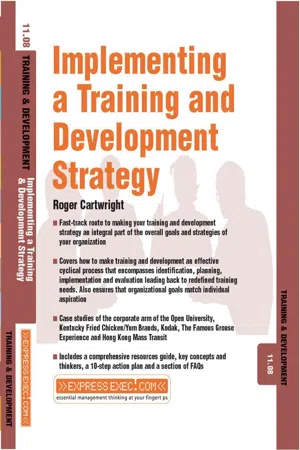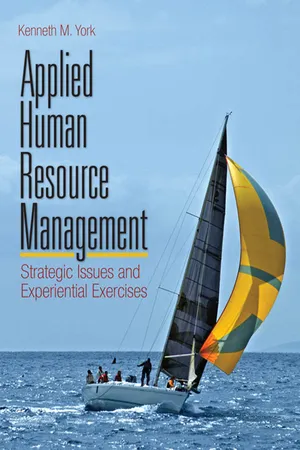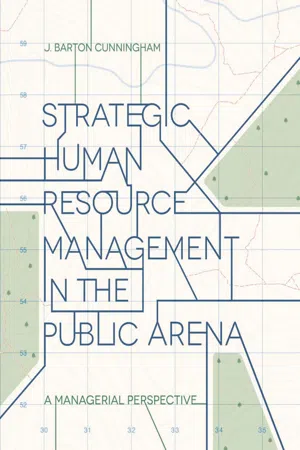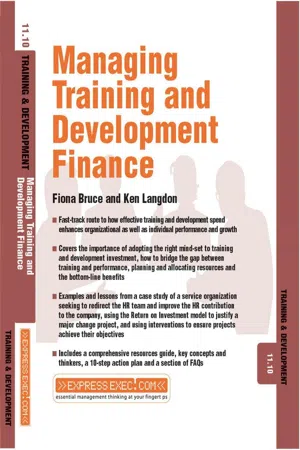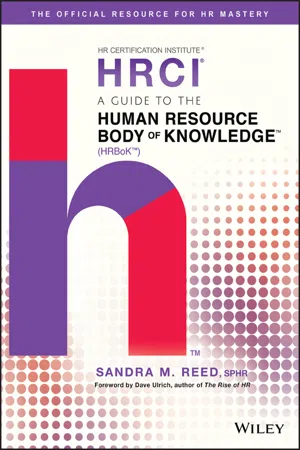Business
Employee Training and Development
Employee training and development refers to the process of equipping employees with the knowledge and skills required to perform their jobs effectively. It involves various learning activities, such as workshops, on-the-job training, and mentoring, aimed at enhancing employees' capabilities and performance. This process is essential for improving employee satisfaction, retention, and overall organizational success.
Written by Perlego with AI-assistance
Related key terms
1 of 5
11 Key excerpts on "Employee Training and Development"
- eBook - PDF
- David A. DeCenzo, Stephen P. Robbins(Authors)
- 2014(Publication Date)
- Wiley(Publisher)
Thus, training involves teaching new skills, knowledge, attitudes, and/or behavior. 31 This may mean changing what employees know, how they work, or their attitudes toward their jobs, coworkers, managers, and the organi- zation. Managers, possibly with HRM assistance, decide when employees need training and what form that training should take (see Diversity Issues in HRM). For our purposes, we will differentiate between employee training and employee development for one particular reason: Although both are similar in learning methods, their time frames differ. Training is more present-day oriented; it focuses on individuals’ current jobs, enhancing those specific skills and abilities needed to immediately per- form their jobs. For example, suppose you enter the job market during your senior year of college, pursuing a job as a marketing representative. Despite your degree in market- ing, you will need some training. Specifically, you’ll need to learn the company’s policies and practices, product information, and other pertinent selling practices. This, by defi- nition, is job-specific training, or training designed to make you more effective in your current job. Employee development, on the other hand, generally focuses on future jobs in the organization. As your job and career progress, you’ll need new skills and abilities. For example, if you become a sales territory manager, the skills you need to perform that job may be quite different from those you used to sell products. Now you must supervise sales representatives and develop a broad-based knowledge of marketing and specific management competencies in communication skills, evaluating employee performance, and disciplining problem individuals. As you are groomed for positions of greater responsibility, employee development efforts can help prepare you for that day. Determining Training Needs Determining training needs typically involves generating answers to several questions (see Exhibit 8-3). - eBook - PDF
Implementing a Training and Development Strategy
Training and Development 11.8
- Roger Cartwright(Author)
- 2003(Publication Date)
- Capstone(Publisher)
The company has established a continuous learning culture in the company in order to enable it to survive in a dynamic business environment. Staff training and development mainly includes two aspects: » Management Training and Development; and » Operations Training. 80 IMPLEMENTING A T&D STRATEGY The company training center at its Kowloon Bay headquarters is equipped with comprehensive multimedia facilities, classrooms, com- puter-based training system, and an audiovisual and multimedia produc- tion center. In addition there is operational and technical training equipment including Driving Cab Simulators, Automatic Fare Collection System and Platform Screen Door. Management Training and Development The Management Training and Development team aims to achieve various business objectives through working with line departments as strategic partners and developing a motivated, competent and produc- tive workforce in a cost-effective manner. » Management development training courses: A full range of courses have been designed and conducted regularly for different groups of staff to improve their skills and knowledge in tasks and people management. The courses cover a wide range of topics including language, project management, change manage- ment, presentation, creativity, and leadership. » Value creation seminars: This is a series of seminars aimed at encouraging employees to face adversities positively and to promote continuous improvement within themselves. » Learn-at-lunch (spare)-time: These sessions are to encourage staff members to make good use of their lunch and spare time by learning new skills. It is perhaps part of the Chinese philosophy and culture that such sessions are highly valued. The employees see that the organization is prepared to invest in them and they in turn are willing to invest some of their personal time. - Ronald R. Sims(Author)
- 2002(Publication Date)
- Praeger(Publisher)
Chapter 7 Human Resources Development INTRODUCTION Organizations today are increasingly recognizing the importance of devel- oping their human resources. The training function, now popularly referred to as human resources development (HRD), coordinates the organization's efforts to provide training and development experiences for its employees. Although training is often used in conjunction with development, the terms are not synonymous. Employee training can be defined as a planned at- tempt to facilitate employee learning of job-related knowledge, skills, and behaviors or helping them correct deficiencies in their performance. In con- trast, development is an effort to provide employees with the skills needed for both present and future jobs. This chapter stresses the point that in the future the only winning or- ganizations will be those that respond quickly to the issue of training and development- related problems. If an organization wants to succeed, it must recognize the importance of investing in its greatest resource- the force working for it. In this chapter, we discuss developing human resources as key to organizational success. Developing human resources is the next stage in the process of achieving organizational success. We first discuss human resources development and organizational strategy. We then take a look at the role of EEO in organizational efforts to develop human potential. Then we discuss a special form of employee development, new employee orien- tation. Next we examine how organizations go about assessing their train- ing and development needs. Then we discuss setting training and development goals. Next we discuss the actual development of training and development programs and include a look at the importance of learning 166 Organizational Success through Effective Human Resources Management principles. Training and development techniques and methods are then in- troduced and discussed.- eBook - ePub
Applied Human Resource Management
Strategic Issues and Experiential Exercises
- Kenneth M. York(Author)
- 2009(Publication Date)
- SAGE Publications, Inc(Publisher)
At different stages of their careers, employees need different kinds of training and different kinds of development experiences. Although a business degree might prepare students for their first job, they will need to gain knowledge and skills through education and experience as they progress through their career. Peters (2006) suggests that there are four stages of management education with different learning outcomes:- Functional competence, an understanding of finance, accounting, marketing, strategy, information technology, economics, operations, and human resources management;
- Understanding context and strategy and how organizational processes interrelate, to make sense of societal changes, politics, social values, global issues, and technological change;
- Ability to influence people, based on a broad understanding of people and motivations; and
- Reflective skills, to set priorities for work efforts and life goals.
Therefore, to maximize the effectiveness of training and development, organizations must constantly assess their employees’ current training and development needs and identify training and development needs to prepare employees for their next position. This requires that organizations recognize that different employees will have different needs and that these needs will change over time as these workers continue in their careers.Strategic Issues in HRM EMPLOYEE DEVELOPMENT AND TURNOVERInvesting in human resources through training and management development improves individual employee capabilities and organizational capabilities. But investing in people is not the same as investing in equipment or machinery. When an organization invests in new computers, for example, the cost can be depreciated over multiple years; but when an organization invests in management development, it is a cost for that year and cannot be depreciated. So from an accounting point of view, dollar for dollar, it is better to invest in the equipment that employees use than it is to invest in the employees using that equipment. - eBook - PDF
Strategic Human Resource Management in the Public Arena
A Managerial Perspective
- John Cunningham(Author)
- 2017(Publication Date)
- Red Globe Press(Publisher)
CO 2: Illustrate how experiential learning principles can be used to enhance training and development. A DRIVING ISSUE FOCUSING MANAGERIAL ACTION: LINKING TRAINING TO APPLICATION Training and development is a multi-billion-dollar industry, with over £93 billion ($141 billion) spent in North America and £261 billion ($396 billion) globally in 2013, a growth of 5.2 per cent over the previous year. 1 Training and development means different things in public organizations, ranging from providing infor-mation on procedures to developing an employee’s competencies. Some training programmes are used to communicate procedures and protect organizations from potential litigation by providing information about 202 Strategic Human Resource Management in the Public Arena controversial topics and laws relating to sexual harassment, pay equity, employment equity, occupational health and safety or new administrative processes, technical processes, technology and customer requirements. For others, training is about developing employee competencies so they can be more effective in working towards an organization’s strategic objectives. Given that there are many meanings of training, labelling everything as ‘training’ might send a foggy message to employees. 2 The success of any training and development programme often is based on its ability to encourage partici-pants to use and apply relevant information. As such, training and development of competencies is more effec-tive if it is viewed as an experiential process that involves information exchange and application of the concepts alongside opportunities to observe others and reflect on the learning. Whether the purpose is to learn how to ride a bike, sail a boat or improve one’s conflict resolution skills, this definition of training and development involves experientially applying competencies to meet defined needs. - eBook - ePub
The SAGE Handbook of Industrial, Work & Organizational Psychology
V2: Organizational Psychology
- Deniz S Ones, Neil Anderson, Chockalingam Viswesvaran, Handan Kepir Sinangil, Deniz S Ones, Neil Anderson, Chockalingam Viswesvaran, Handan Kepir Sinangil, Author(Authors)
- 2017(Publication Date)
- SAGE Publications Ltd(Publisher)
The chapter is organized in three major sections. In the first section, we present a conceptual framework of development in the workplace. The framework is informed both by broader theories of human learning and development and by practice-specific models of workplace development. In the second section, this framework is used as a platform for synthesizing and comparing recent research on practices currently being used by organizations to promote development in the workplace. We review six popular practices: 360-degree feedback, developmental assessment centers, executive coaching, formal mentoring, developmental job assignments, and action learning. In the final section of the chapter, we look at the changing landscape of development practices and offer recommendations for future research.Throughout the chapter, we focus on what has been learned about the development of employees, including leaders, since 2000. Relevant articles and chapters have appeared in a number of related disciplines, including psychology, human resource development, and human resource management. Within this literature, a variety of related concepts have been defined and studied. Employee development (Noe & Tews, 2014), leader development (Day, 2001), continuous learning (Kuznia, Kerno, & Gilley, 2010), continuous employee development (Garafano & Salas, 2005), informal learning (Tannenbaum, Beard, McNall, & Salas, 2010), self-development (Boyce, Zaccaro, & Wisecarver, 2010), and employee development activity (Maurer, Lippstreu, & Judge, 2008) are some of the terms that have been used to describe work-related learning and development. We have drawn broadly from theory, research, and practice in these overlapping domains, explicitly excluding only work on what classically has been defined as training.There is considerable similarity between some definitions of training and development. Both involve improvements in individuals’ capacity to perform current or future work (McCauley & Hezlett, 2001). Key differences between the two have historically included: (1) formal education and training often occur offsite, or off-the-job; (2) training typically is more greatly structured by the organization; and (3) training tends to place greater emphasis on growth relevant to current roles, while development encompasses long-term professional and personal growth (McCauley & Hezlett, 2001). Changes in training and development (Bell & Kozlowski, 2010) are increasingly blurring even these differences. We see formal education and training programs as one kind of developmental experience, but exclude it from our review due to the substantial size of the literature on training. In Chapter 10 in this Handbook, Bell and Moore address this topic, delving into key advances in training design and delivery, team training, training transfer and training evaluation. - eBook - PDF
Performance Improvement
Making it Happen, Second Edition
- Darryl D. Enos, Dana Vincent J.M., Suzanna E. M.D.(Authors)
- 2007(Publication Date)
- Auerbach Publications(Publisher)
223 Chapter 15 PROGRAMS FOR TRAINING, DEVELOPMENT, AND EDUCATION: HELPING PEOPLE LEARN FOR PERFORMANCE INTRODUCTION People working in organizational development or performance improve-ment often use the terms “training,” “development,” and “education” more or less interchangeably. While these are distinguishable performance development initiatives, they share a common purpose, which is to provide participants with concepts, techniques, motivation, and skills that can enhance performance now or in the future. In various ways, these three learning initiatives seek to inform us, provide us with concepts with which to work, teach us skills necessary for performance, and encourage positive attitudes and motivation so that we will use the concepts and skills successfully. DISTINGUISHING TRAINING, DEVELOPMENT, AND EDUCATION These three terms are used in various ways in different organizations. Because so much effort and resources are put into the three areas, clarifying what each means can help organizational leaders in deciding how and where to use these learning initiatives. The organizational use 224 Performance Improvement of these interventions is enormous. In early 1998, the ASTD estimated that all U.S. organizations spent a total of $55.3 billion on training in 1995. (1) This expenditure probably did not include the salaries of participants in training or the cost of some educational programs such as college tuition or executive development seminars. 1. Education, in terms of current usage in organizations, is the broad-est of the three terms. Most commonly, the term “education” is used in two ways by organizations. First, education is used to mean everything an organization does to support learning, including job training, executive development, and tuition support for college courses. Second, the term is used to mean an organization’s support for its employees attending college. - Surbhi Jain(Author)
- 2019(Publication Date)
- Society Publishing(Publisher)
INTRODUCTION TO TRAINING AND DEVELOPMENT CHAPTER 1 “Learning never exhausts the mind,” —Leonardo Da Vinci CONTENTS 1.1 Chapter Summary ................................................................................ 2 1.2 Functions of Human Resource (HR) Management ................................ 2 1.3 Effective HR Management .................................................................. 11 1.4 The Difference Between Training and Development ........................... 21 1.5 The Importance of Training and Development in an Organization ...... 23 1.6 Conclusion ........................................................................................ 27 Key Trends in Corporate Training & Development 2 1.1 CHAPTER SUMMARY Training and development is one of the important functions of the human resource (HR) department. It allows the department to prepare the employees for excellence when performing a range of tasks. This chapter introduces the concepts by first defining the general functions of the HR department. The numerous approaches and strategies to ensure that effectiveness is achieved by the management are then discussed. Focus is also given on the difference between and the importance of training and development. Delving into the details will allow the reader to have sufficient background information on the topic of discussion. 1.2 FUNCTIONS OF HUMAN RESOURCE (HR) MANAGEMENT Human resource management, also abbreviated as HR, focuses on how people are employed and managed in a firm. The concept evolved from the terms personnel and welfare management. It became critical in the 1980s when the leaders in organizations realized that they needed to take a different approach after experiencing recession and pressures of the globalization and the rapid technological advancement. It was critical that the firms achieve competitive advantage by managing all their resources effectively, including the HR.- eBook - PDF
Learning and Development for Managers
Perspectives from Research and Practice
- Eugene Sadler-Smith(Author)
- 2009(Publication Date)
- Wiley-Blackwell(Publisher)
However, as outlined above there are valid conceptual reasons for using the term ‘learning and devel-opment’, not least because of increasing interest in and recognition of the processes of informal learning, including the role of implicit learning and tacit knowledge, in organizations. Learning and development represent processes that may be supported by events such as training, education or working. There are also national cultural differences in aspects of terminology. For example in the USA the term ‘instruction’, ‘instructor’ and the associated concept of instructional design is not uncommon; indeed the classic 1979 text for learning design by Gagné and Briggs is called Principles of Instructional Design (see Gagné et al. 1992). The equivalent term in the UK would have been ‘training design’ or more latterly ‘learning design’. In some practitioner circles the term ‘training and development’ (T&D) appears, at the time of writing, to be holding up. Terminologies in the field are diverse. 18 INTRODUCTION TO LEARNING AND DEVELOPMENT Systematic training (1950s–1960s) Self-development, action learning and work-based learning (1970s–1980s) Learning organization and e-learning (1990s) 2000s? Figure 1.3 An accretionary model of the development of L&D practices (after Pedler et al., 1997: 12–14) Whilst human resource development (HRD) is often concerned with the tactical and strategic management of organized learning and development processes in organizations (see Dooley 1945; Nadler 1970; Davis and Mink 1992; Grieves and Redman 1999), L&D, as defined for the purposes of this book, takes a broader view of learning as occurring in both explicit and implicit ways. To this extent L&D has two facets. Firstly, it is concerned with describing, explaining and under-standing the informal and formal, planned and unplanned learning processes that occur in organizations. Secondly, it is concerned where possible with enabling, facilitating and managing these processes also. - eBook - PDF
Managing Training and Development Finance
Training and Development 11.10
- Fiona Green, Ken Langdon(Authors)
- 2004(Publication Date)
- Capstone(Publisher)
» Investing in team-working training and development is a given in any successful organization nowadays. » The T&D plan is most effectively used in an environment where management is seen as a craft rather than a science. 11.10.09 Resources This chapter refers to books, Websites, and other publications relevant to the T&D finance topic. 92 MANAGING T&D FINANCE BOOKS We have picked out five books that Fiona has found particularly helpful in developing her knowledge of training and development, and their management. John Kenney & Margaret Reid, Training Interventions, Institute of Personnel Management, 1986 Training Interventions gives an overview of the main issues in training and contains many useful references for those wishing to study aspects in more depth. Beginning with a consideration of the nature of training and its organizational role – the organization is seen as a powerful learning environment, and training is regarded as a deliberate inter- vention in this book – the book continues with the assessment of organizational and individual needs, and the planning and evaluation of training strategies. The authors consider issues in the training of young people and adults, and the book concludes with a chapter on the evolving national training scene. Nick Georgiades & Richard Macdonell, Leadership for Competitive Advantage, Wiley, 1998 For those people involved in transforming their organization, this book balances academic knowledge with practical experience. It answers the real and complex needs of leaders attempting to balance the seemingly conflicting demands of a turbulent external environment and the needs of the shareholders, customers, and employees. The book outlines an interesting ‘‘Model of Organizational Effective- ness’’ that is a guide to sorting and assigning priorities for action. It enumerates the key steps in the process of making significant change, and offers hints and practical advice to help the reader on his or her individual journey. - No longer available |Learn more
- Sandra M. Reed(Author)
- 2017(Publication Date)
- Wiley(Publisher)
Coaching relationships require trust, and an employee may not be willing to reach and fall short if she knows that she will be reprimanded for her failures. Development activities are focused on behaviors that must be learned or acquired, as opposed to current job performance. In formal coaching programs, both internal and external resources may be identified. The use of mentors may be beneficial when a more neutral approach is desired. As always, HR must model and communicate the expected standards of behaviors for the coaches, help identify the desired outcomes from the coaching intervention, and communicate the value of the program to the executive team. Apprentice programs are a formal method for establishing benchmark job skills and knowledge. More commonly found in the trade industries, apprentice programs have a very clear path to certification and expertise that is guided by skilled professionals. Another technique that is effective in developing people is job rotation. This involves cross-training employees in multiple roles to improve their skill set overall. While it can be cumbersome to track and administer, the long-term value of having a cross-trained workforce can work to the advantage of an organization, particularly in the realm of knowledge management. Stretch assignments are those that require the employee to learn something new or apply different critical thinking skills. These can be the result of special projects, or an increase in job responsibilities for practice. HR can support these types of exercises by identifying opportunities, recommending employees for consideration, and evaluating performance, working in tandem with the developing employee's direct supervisor. Resources for developing employees may also occur off-site. Continuing education through certificatio n programs offers professional credential s that have been linked to positive employment outcomes. Seminars are useful for a focused view on specific topics, especial labor laws
Index pages curate the most relevant extracts from our library of academic textbooks. They’ve been created using an in-house natural language model (NLM), each adding context and meaning to key research topics.

